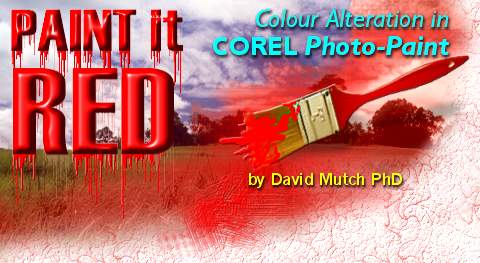
| Introduction Duotone - The Basics Duotone - Advanced Direct from RGB - HSL - Colour Balance - Selective Color - Color Hue & Tone Using Masks Conclusion |
 |
|
|
Selective Colour Another great way to alter
colours is by using the Selective Color controls. This dialog box lets you perform color modifications by adjusting the percentage of the component process colors (CMYK values) within color spectrum options (Reds, Yellows, Greens, Cyans, Blues, Magentas). It may also be used to add process color to the grayscale tonal component of an image. |
|||||||||||||||||||||||||||
|
The Corel PP8 and 9 Help file describes Selective Colour as: "The color modification process is accomplished by increasing or decreasing the percentage of Cyan, Magenta, Yellow, or Black pixels that make up each primary color in the color spectrum. For example, decreasing the percentage of the magenta element in the Reds Spectrum results in a color shift toward yellow, which is replaced with the magenta-rich red pixel. Conversely, decreasing the percentage of magenta in the Reds causes a color shift toward magenta and a reduction in overall red. " "The extent of any color modification depends largely on the Adjustment Percentage method you have selected. The Relative method adds or removes a percentage of the process color to or from the selected color spectrum. For example, adding 10% magenta to a 50% red pixel results in an adjustment of + 5%. The Absolute method adds or removes the absolute value of the process color to or from the selected color spectrum. For example, adding 10% magenta to a 50% red pixel results in an adjustment of + 60%." I'm not sure about you but
that still doesn't make it totally clear to me. However, after experimenting
with the Selective Color controls for a short while I discovered that
they are a very powerful way to alter image colours. I also discovered
that it was also quite easy to create a total disaster at times using
these controls. |
|||||||||||||||||||||||||||
|
That's right - yet another image for you to try. Its not that any of the previous ones weren't suitable but I believe that, in order to test out these many and varied methods its probably best to use a number of different images to examine the effects properly. For our experiments with the Selective Color controls, I have selected the 702003.wi image from the Photo-Paint 8 Disk 3 folder Photos/Couplesii. This is a bright image with contrasting foreground and background colours. Click HERE
or on the image to download a resampled, smaller version. |
|||||||||||||||||||||||||||
|
The Selective Color Dialogue Box With your new image opened and a Checkpoint set, open the Selective Color dialogue - Image > Adjust > Selective Color.
Clicking the RESET button in PP8 sets the default adjustment method to Absolute. However clicking the same button in PP9 sets it to Relative. For this image, with the default Reds spectrum radio button selected, the Cyan slider is available for Absolute adjustments but not for Relative. This is similar for all RGB spectra (Reds, Greens or Blues), where their opposite (Cyan, Magenta, Yellow respectively) is unavailable in Relative adjustments. The CMYK sliders are always available all the time in both adjustment modes for the CMYK spectra. |
|||||||||||||||||||||||||||
|
A Test Run -
With the 'Reds' radio button selected try adjusting all the sliders in
both modes - Try switching between Relative and Absolute modes after changing a setting. - Click the RESET button if you get into too much of a mess. |
|||||||||||||||||||||||||||
|
Some Example Settings
OK, Lets have some fun. The
original is placed close by for comparison
CODES and sequence of actions: Therefore first select the
adjustment method. Then select the correct spectrum radio button and adjust
the sliders. Then select the next spectrum button and adjust the sliders
etc. (if any). Remember to restore your original image (Edit
> Restore to Checkpoint) and to click RESET
on the dialogue box if you've previously clicked OK
on any changed setting. |
|||||||||||||||||||||||||||
|
|
 |
 |
 |
||||
| Copyright
©, 1999. David Mutch Ph.D. and Visionary Voyager Corporation. All rights reserved. |
||||||